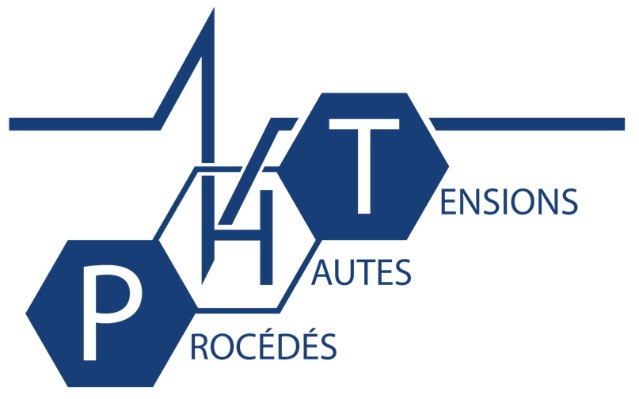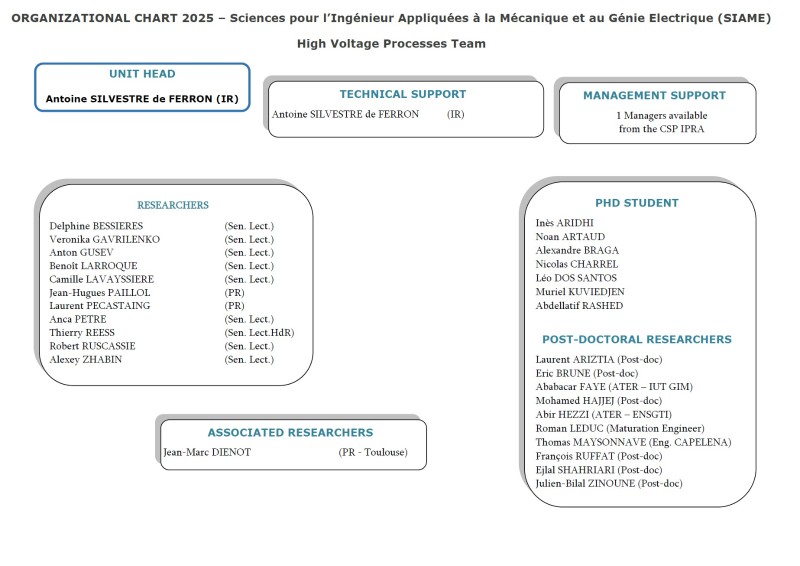High voltage processes team

The PHT team is composed of :
- 12 Teachers / Researchers
- 1 technical support staff
- 1 administrative support staff
- 7 PhD students
- 9 post-doctoral students
The main research subjects of the high voltage processes team are:
- Generating high voltage transients and high power pulses.
- Developing HV measurement devices.
- Industrial applications based on high power pulses.
With the help of Anthony LACAZE from the LinkMedia company, we were able to produce the video presentation of the Team below.
The basic principle of HPP is based on the relationship between the electrical energy and instant power.
At constant energy, the aim is to amplify electrical power to compress the time variable. This operation takes place in two stages: a slow energy storage phase followed by fast restitution of the energy towards the load. Depending on applications, requirements will essentially focus on a peak voltage level, a leading edge, a duration, a specific wave shape and/or a repetition frequency. Consequently, using HPP requires perfect knowledge of power switching and the shaping of high-voltage pulses.
The electrical power, conditioned to be delivered within very short intervals, can be used to create intense electrical fields, high-power micro-waves, cold plasmas, shock waves, electron beams, X-rays, etc.
The areas of research of the team can be divided into two categories: High-voltage generation and processes and Multiphysics modeling, characterization and optimization.
High-voltage generation and processes
The competencies used in this area of research include:
- Power switching (gas, liquids, semi-conductors).
fast and compact Marx generators, etc.).
- The generation of pressure waves in water and how to optimize them.
- The development of innovative amplifying structures
(resonating and pulse transformers,
- Pulse shaping
(sub-nanosecond unipolar and/or bipolar pulses,
damped sine waves, rectangular pulses, etc.).
- The generation of pulsed fields.
- Pulse metrology (HV, strong currents, ULBs, fields).
The aim of our work is, first, to continue developing very high peak power systems, and second to carry on work to improve the capacity of devices to function at average powers for potential industrial applications, which until now had been out of the question. For this purpose, we can rely on a well-equipped experimental hub mainly composed of “homemade” prototypes.
To obtain increasingly high peak powers we need to implement new structures to optimize the voltage gradient generated, study new components and also develop metrology resources to guarantee the accuracy of the results observed. In this respect, research is seeking to improve the dynamics and range of measuring instruments (voltage, current, fields).
Multiphysics modeling, characterization and optimization
The competencies used are:
- Numerical modeling and simulation of filament discharges at atmospheric pressure.
- Study of coupled EM fields and complex dielectric media.
- The characterization of dielectric materials subject to electrical constraints.
- The electrical characterization of porous media.
- Thermoelectricity (modeling, characterization, implementation, optimization).
- Knowledge of electromagnetic interferences: EM characterization and simulations.
In terms of modeling, current work focuses on the study of the fundamental mechanisms at play in the interaction between the positive streamer and the cathode in order to simulate the negative corona discharge. The model is developed such as to take into account complex dielectric media when they interact with the discharge.
As regards characterization, efforts concentrate on understanding the degradation mechanisms of the insulants used for high-frequency coils and on developing experimental techniques for characterizing dielectric materials (LIM method) and a technique for characterizing porous media based on electrical measurements.
Finally, the objective of research activities on thermoelectricity is to achieve non-stationary modeling of phenomena and to optimize thermoelectric systems based on a typical operating cycle. Depending on results, experiments to characterize new materials with enhanced properties could allow us to consider new applications for this technique.
